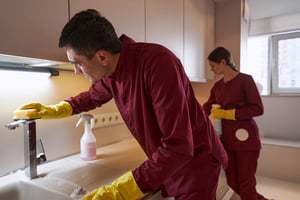Keeping your home or workplace clean is essential, but sometimes life gets in the way, and...
How Professional Cleaners Tackle Tough Stains

Stubborn stains are the bane of any clean space. From wine spills on carpets to grease marks on upholstery, tough stains require skill, patience, and the right techniques to remove effectively. Professional cleaners are experts at tackling these challenges, ensuring that surfaces are restored to their former glory without causing damage. Here, we delve into the secrets behind how professionals handle tough stains and provide practical tips you can use at home.
1. Assessing the Stain
Before diving into stain removal, professional cleaners always start by assessing the stain. Key factors they consider include:
-
Type of Stain: Is it organic (e.g., food or wine), inorganic (e.g., ink or paint), or oil-based? Different stains require different treatments.
-
Surface Material: The cleaning method varies significantly depending on whether the stain is on fabric, carpet, wood, or tile.
-
Age of the Stain: Fresh stains are generally easier to remove, while older stains may require more intensive treatment.
Example Tip: For a fresh coffee spill on your carpet, blot the area with a clean, dry cloth to absorb as much liquid as possible before applying any cleaning solution.
2. Using the Right Tools and Products
Professional cleaners rely on a combination of high-quality products and specialised tools to tackle stains effectively. Common items in their arsenal include:
-
Enzymatic Cleaners: Ideal for organic stains like blood or pet accidents. These break down proteins to lift stains effectively.
-
Steam Cleaners: Used for deep cleaning carpets and upholstery, steam penetrates fibres to loosen dirt and kill bacteria.
-
pH-Neutral Solutions: Safe for delicate surfaces like natural stone or fine fabrics.
-
Specialised Brushes and Pads: These help agitate stains without damaging the surface.
Example Tip: Avoid using harsh bleach on coloured fabrics. Instead, opt for an oxygen-based cleaner to lift stains gently without fading the material.
3. The Science of Stain Removal
Professional cleaners understand the science behind stains and tailor their approach accordingly. Stains have chemical properties that dictate the most effective cleaning method. For instance:
-
Oil-Based Stains: Grease and oil repel water, so solvents or degreasers are used to break them down.
-
Protein-Based Stains: Blood, egg, or dairy stains require cold water and enzymatic cleaners to prevent setting.
-
Tannin Stains: Tea, coffee, and wine stains respond well to acidic solutions like white vinegar.
Example Tip: For red wine spills, sprinkle salt over the stain immediately to absorb excess liquid. Follow up with a vinegar and water solution for cleaning.
4. Step-by-Step Stain Removal Techniques
Carpet Stains
-
Step 1: Blot the stain with a clean cloth—never rub, as this can spread the stain.
-
Step 2: Apply a cleaning solution (like a mix of dish soap and water) to the area. Let it sit for 5-10 minutes.
-
Step 3: Blot again with a clean, damp cloth to lift the stain. Repeat if necessary.
Upholstery Stains
-
Step 1: Vacuum the area to remove loose dirt and debris.
-
Step 2: Spot-test a cleaning solution on a hidden area to check for colourfastness.
-
Step 3: Gently dab the stain with the solution using a microfibre cloth. Avoid soaking the fabric.
Hard Surface Stains (e.g., Tile or Stone)
-
Step 1: Wipe the area with a damp cloth to remove loose dirt.
-
Step 2: Apply a pH-neutral cleaner or a paste made from baking soda and water.
-
Step 3: Scrub gently with a soft brush and rinse thoroughly.
5. Avoiding Common Mistakes
Even with the best intentions, tackling stains without proper knowledge can make them worse. Here are some common mistakes professionals avoid:
-
Using Hot Water on Protein Stains: Heat sets protein-based stains, making them harder to remove.
-
Rubbing Instead of Blotting: Rubbing can push stains deeper into fibres, causing permanent damage.
-
Over-Saturating the Area: Excess moisture can lead to watermarks or mildew, especially on fabrics and carpets.
-
Skipping a Spot Test: Always test cleaning products on a small, inconspicuous area to avoid discolouration or damage.
Real-Life Examples from Professionals
Case Study 1: Red Wine on a White Carpet A professional cleaner faced a large red wine spill on a client’s cream-coloured carpet. Using a combination of salt to absorb moisture and a commercial carpet cleaner, they successfully lifted the stain without leaving a trace.
Case Study 2: Grease Stain on Upholstery A grease stain on a fabric sofa was treated with a solvent-based cleaner, followed by steam cleaning. The sofa looked as good as new, with no damage to the fabric.
Case Study 3: Ink on a Wooden Desk Ink stains on a polished wood surface were removed using rubbing alcohol applied with a cotton swab. The surface was then polished to restore its shine.
When to Call the Professionals
While some stains can be managed at home, others require professional expertise. Call in the pros if:
-
The stain is large or has set deeply.
-
You’re dealing with delicate materials like silk or antique fabrics.
-
DIY attempts have failed, and you don’t want to risk further damage.
Trust Hello Clean Group for Expert Stain Removal
At Hello Clean Group, we specialise in tackling even the toughest stains with precision and care. Our experienced team uses advanced techniques and tools to restore your carpets, upholstery, and surfaces to their original state. Say goodbye to stubborn stains and hello to spotless spaces!
📞 Call us on 0191 659 9069 or 07511 336 499
💻 Visit www.hellocleangroup.co.uk to book your professional cleaning service today!


